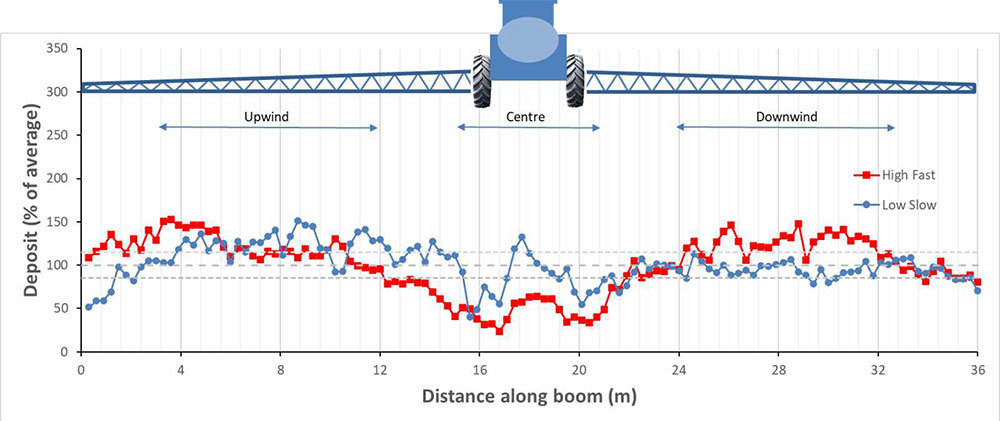Uniformity of sprayer deposition needs improvement
Key result:
The range in on-target spray deposition volume across the width of sprayers was unexpectedly large for this study. With each sprayer pass, some targets only received one third of the intended dose while others received triple the intended dose.
Project title, principal investigator:
“Characterizing turbulent spray deposition from self-propelled sprayers” Tom Wolf, Agrimetrix
Funding:
SaskCanola, Alberta Canola
Full report:
To find the full report, go to SaskCanola’s research page at saskcanola.com/research-results and search for the project title.
Spray deposition across the width of a boom, based on results from this study, was not as uniform as principal investigator Tom Wolf would have hoped to see, and the path to effective improvement is not clear.
The “best” configuration of low boom height, slow travel speed and coarser spray was only somewhat more uniform compared to the alternative of higher boom height, faster travel speed and finer spray.
Trials compared various configurations of boom height, travel speeds, boom widths and spray qualities (coarse, medium, etc.) on Rogator RG1100B, John Deere R4045 and John Deere 4830 sprayers. Data collected came from field trials and computer modelling.
Results
Higher wind speeds increased variability, as did a combination of higher booms and faster travel speeds. Finer sprays also tended to deposit less uniformly. Deposit patterns, and the magnitude of the associated variability, were only moderately repeatable, but some similar trends were apparent. The first was the downwind displacement of the edges of the spray swath. The second was the overall lower deposition in the wake of the sprayer wheel tracks. The final common observation was the greater variability of the deposit in the centre of the spray boom, behind the tractor unit, than for the boom wings.
Computational fluid dynamics studies showed that disturbances in the flow field were increased with travel speed and boom height. In computer modelled data, both upward and lateral components were increased similarly, increasing the potential for spray droplets to be directed off target. Tire width had an impact on flow field disturbances. Not only was greater turbulence observed in the wake of the wider tires, the width of the tire-induced wake was several tire widths more than the width of the tractor unit.
This study demonstrated that the uniformity of spray deposits from modern self-propelled sprayers is lower than predicted in existing lab and field studies. Efforts to reduce the variability using lower booms, lower speeds, and coarser sprays was met with some success. However, even the “best” configuration (low boom, slow travel speed, and coarser spray) was only somewhat more uniform compared to the alternative (high boom, fast speed, and finer sprays). Although the overall effect of slower speeds and lower booms were not as large as hoped, they nonetheless represent the single best tool available to applicators at this time.
Average of replicate lines for “High & Fast” and “Low & Slow”, 2019Low boom height and slow ground speed has somewhat better uniformity than high boom height and fast ground speed. This graph is based on 2019 results. It compares a medium spray quality operated at a 40” boom height and a speed of 18 mph (high and fast) to the same nozzle operated at a 24” and 7.3 mph (low and slow). However, the improvement was not a great or as consistent as the researchers might have expected.






